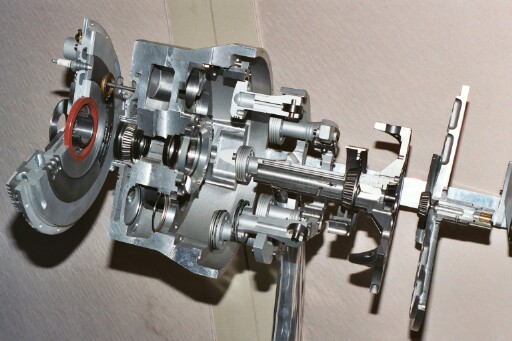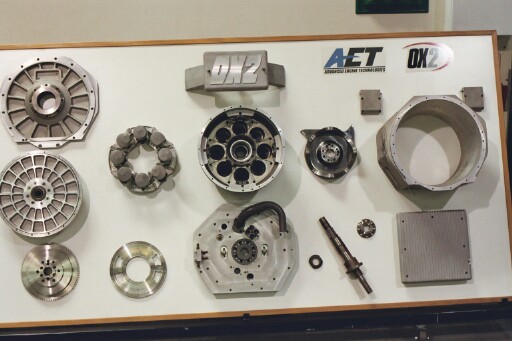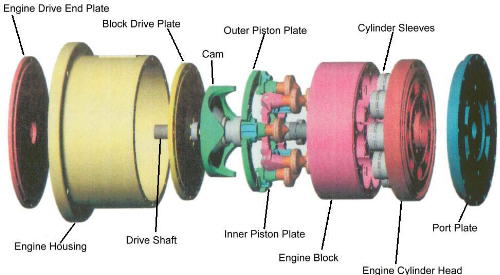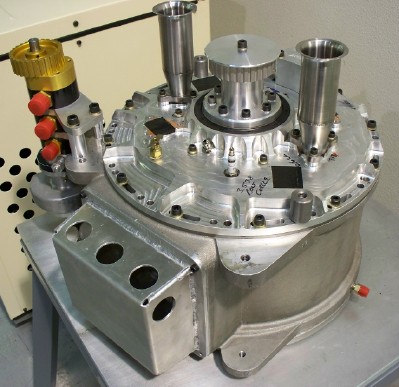OX2 Engine Description
Product Overview
The OX2 internal combustion engine is fuel efficient, light weight, low emission, multi fueled, smaller, inexpensive, higher power to weight ratio and without complex manufacture/production requirements. Preliminary statistics have shown the OX2 engine either meets or in most cases exceeds requirements in all area of existing internal combustion engines. The OX2 engine will be applied from zero to multi thousand horse-power, for lawn mowers, chain saws, brush cutters, marine inboard/outboards, generators, pumps, welders, aircraft, automotive and industrial engines.
The fact that the OX2 engine has only six major components, of which only three move, results in low set-up and production costs with a simplicity of design that promotes a high level of quality assurance.
The major parts are as follows: (1) housing, (2) cylinder block, (3) outer piston plate, (4) inner piston plate, (5) cam track, and (6) drive shaft. The moving parts are: (1) cylinder block, (2) outer piston plate, and (3) inner piston plate.
The current core prototype Level 3 OX2 engine is composed of a total of just 57 individual parts. 36 parts are off-the-self and 21 parts are manufactured in-house specifically for the engine. (This does not include external parts such as an oil pump, starter, turbocharger, radiator, coils, and controls.)
The OX2 engine has undergone three major design changes with the current design referred to as "Design Level 3". The photos below represent the three designs . Design Level 3 has no center shaft. The engine block itself serves as the shaft supported by bearings on both ends. Rotary motion is transferred from the piston plates to the engine block via roller bearings (part "8" below) to vertical slots in the engine block (part "1" below). There is no side force on the pistons themselves.
 Level 1
 Level 2 | Level 3 |
The data given below is related to the current prototype however it should be noted that the engine is flexible enough to allow these parameters to change to best suit a particular application. The current prototype is designed specifically to meet the requirements needed to power a 30 kW generator, requiring a minimum of 45hp and 250 ft-lbs. The current prototype size and configuration could potentially accommodate a cylinder bore up to 80 mm, and, with a 45 mm piston stroke, up to a 1.8 Liter displacement. Scaling up from the performance results of the current 1.1 Liter configuration, a 1.8 Liter OX2 engine with turbocharger could potentially produce 118 hp and 518 ft-lbs @ 1200 rpm.
Number of Combustion
Chambers 8
System 4 Stroke
Diameter 17 inches/432 mmLength 13 inches/330 mm
Weight 175 lbs/79.5 kilos
Actual Cubic Capacity 67 cu in/1100 cc
Cylinder Bore 2.9 inches/74 mmPiston Stroke 1.3 inches/33 mmHorsepower 47 hpTorque 316 ft lbs @ 780 rpmFuel Gasoline
Brief Synopsis of the OX2 Engine
Set forth is a comparison and description of the operation of the OX2 engine against a normal four stroke conventional engine (hereinafter referred to as "4sc Engine").
The current prototype of the OX2 engine fires two spark plugs simultaneously in two cylinder chambers with appropriate leads and coils. There is no crank shaft or distributor. Originally designed not to require an oil pump, an oil sump pump system is now a part of the current prototype to assure proper oil distribution. It is water cooled and may or may not be configured with a turbocharger. A conventional starter starts the engine. Currently being test with a mechanical governor, an electronic throttle control being developed will enable the OX2 engine to run at optimum speeds to match loads in stationary applications such as a generator or pump through a computer controlled feedback loop.
The combustion chambers are only slightly longer than the stroke, (e.g. a 75mm. stroke requires a 87 mm. combustion chamber) and pistons need only to be thick enough to house the rings. There are no piston skirts and the rings are the only contact point with the bore. In other words at no time do the pistons touch the bore and nor are they reliant on it for support. This system eliminates loading on the sides of the combustion chambers.
Not counting seals and bearings the OX2 engine has only six major components, and should be easier to manufacture than a cylinder head of a conventional four cylinder engine. There are only two wearing parts, which would wear at a rate similar to ordinary piston rings. Once the engine is set to its operating setting it needs little or no servicing.
The current OX2 engine fires four times as often as a 4scEngine, i.e. For every complete cycle of a 4scEngine the OX2 engine has completed four cycles. Therefore engine capacity of the OX2 engine when compared to 4scEngine is calculated by multiplying the actual engine capacity by four, i.e. the displacement volume of an OX2 engine is equivalent to a 4scEngine with a displacement volume four times the actual OX2 displacement volume. For each revolution of the OX2 engine, each of its 8 cylinders fires twice for a total of 16 firings per revolution. An 8 cylinder 4scEngine fires only four times per revolution. It would take a 32 cylinder 4scEngine to match the OX2 engine's 16 firings and its total displacement per revolution.
Because the OX2 engine does not use a conventional crankshaft it has been able to achieve a leverage advantage of 6.6 times over a 4scEngine which has a similar stroke. The method used to achieve this is the subject of the engine patent.
Further, the OX2 engine design enables the timing to be adjusted sufficiently to produce the most effective burn of the combustible fuel being used irrespective of the engine R.P.M. This is possible due to the extended dwell at the top of the compression stroke. Compare this to a 4scEngine where pre ignition occurs if the timing is advanced to far, causing combustion prior to the top of the stroke. The result of which is resistance against the crankshaft thus causing a loss of energy.
OX2 piston speed (which is controlled by the fuel burn rate) remains constant throughout the entire power stroke at the leverage advantage referred to above. The inlet and exhaust valves do not commence to open until the exhaust and power strokes respectively have been fully completed. They then remain open long enough to ensure maximum operating efficiency. This enables more regulated mixture to be induced prior to firing and for exhaust gases to be expelled efficiently.
Compare this to the combustion signature of a 4scEngine where piston speed increases and decreases twice during the power stroke. To begin with, the majority of the power from the firing occurs at the top of the stroke where there is little or no leverage. By the middle of the stroke (where there is maximum leverage) the piston is out accelerating the maximum burn rate, resulting in a loss of torque. Towards the end of the stroke the piston is decelerating again, the outlet port is starting to open and energy is being lost through the exhaust. Added to this at high revs there is considerable back pressure form exhaust gasses trying to escape out of the valves, again causing resistance and a loss of efficiency. A significant advantage of the OX2 engine design is that it has a capability to lengthen or shorten the piston stroke and dwell at top dead center during engine operation thus ensuring optimum efficiency at all times irrespective of engine revs or load.
A further feature of the OX2 engine is that it achieves considerable torque at all stages through its operating range. Consequently in most applications there would be no need for the engine to operate at revs higher than 2500 rpm. In some instances this would eliminate the need for a gear box and would certainly reduce engine wear. However, if high engine revs is a prerequisite for a particular application, then the OX2 engine can be easily adapted accordingly.
Combustion Chamber & Porting
Conventional Engine
Air & fuel is taken in to the combustion chamber through the intake port and past the intake valve which is located off to one side of the cylinder. The valve being fully open for only a percentage of the stroke and the port size being restricted by the combustion chambers ability to house any larger valve while still leaving room for the exhaust valve. The valves themselves restrict the efficient flow of gasses into and out of the combustion chamber as well as creating turbulence as gasses attempt to flow around them again causing further restrictions to the smooth and efficient flow of gasses.
Air & fuel is taken in to the combustion chamber through the intake port and past the intake valve which is located off to one side of the cylinder. The valve being fully open for only a percentage of the stroke and the port size being restricted by the combustion chambers ability to house any larger valve while still leaving room for the exhaust valve. The valves themselves restrict the efficient flow of gasses into and out of the combustion chamber as well as creating turbulence as gasses attempt to flow around them again causing further restrictions to the smooth and efficient flow of gasses.
OX2 Engine
In the OX2 engine air and fuel is taken in to the combustion chamber through one port located in the center of the combustion chamber. This port could be the size of the chamber if so desired. It is fully opened for the entire duration of the stroke plus some additional time to allow a full chamber of air & fuel. There is no valve restricting the flow and the chamber is convex in shape so as to fully change the cylinder with maximum efficiency. Due to the fact that this port is also the exhaust port a heat transfer takes place on intake thus cooling the port and seal while maximizing fuel vaporization in the one simple process. Added to this is the recirculation of exhaust gasses into the combustion chamber on intake which also assists in the vaporization of the fuel.
Conventional Engine Vacuum
To control engine power and speed the flow of air and fuel is restricted to the combustion chamber via a carburetor or throttle body and fuel injectors. (Less fuel and air results in less potential energy for heat expansion and therefore less power and lower engine revs). The negative affect of this in a conventional engine is high engine vacuum, which produces two energy wasting affects: (1) it takes a great deal of energy for the piston to travel down the bore under such vacuum; and (2) on completion of the intake stroke the combustion chamber still does not have full volume of air fuel mixture, and, as you can only compress what is in the cylinder in the first place, compression will not be optimum. As a result maximum efficiency from the potential energy will not be obtained.
OX2 Engine
The OX2 engine is designed to have exhaust gasses fed back in to the combustion chamber, so as the throttle is backed off more exhaust gasses enter the combustion chamber ensuring that engine pressure is only slightly below atmospheric pressure thus eliminating the majority of the vacuum created. This ensures that there is no waste of energy fighting vacuum and also allows for optimum compression regardless of the air fuel delivery. This means that more fuel is used driving the piston and less wasted pressuring the combustion chamber. As there was little pressure differential the air fuel induced in to the cylinder does not drop in temperature and when the heat of recalculated exhaust gasses is added to this the fuel remains in a gaseous form thus ensuring an efficient burn.
OX2 Engine Patents
To date, three U.S. Patents have been issued for the OX2 engine, numbers 5,813,372, 6,155,214 and 7,428,885. These patents are available for viewing and printing online. They may be accessed directly from the U.S. Patent Office website or from 3rd party patent websites such as Delphion. The patent images are stored in "TIFF" format which requires special software to view them. Delphion's site will allow you to view the patent images and drawings without installing additional software, but you cannot directly print high quality 300 dpi x 300 dpi images from this site. You must order and pay a fee for such a copy. However, you may install a free "plug-in" which will allow you to view and print free 300 dpi x 300 dpi copies of any U.S. Patent on file at the U.S. Patent Office website. The pages must be downloaded and printed one page at a time. You cannot print the entire patent in one step. Instructions on how to access the U.S. Patent Office images can be found here.

